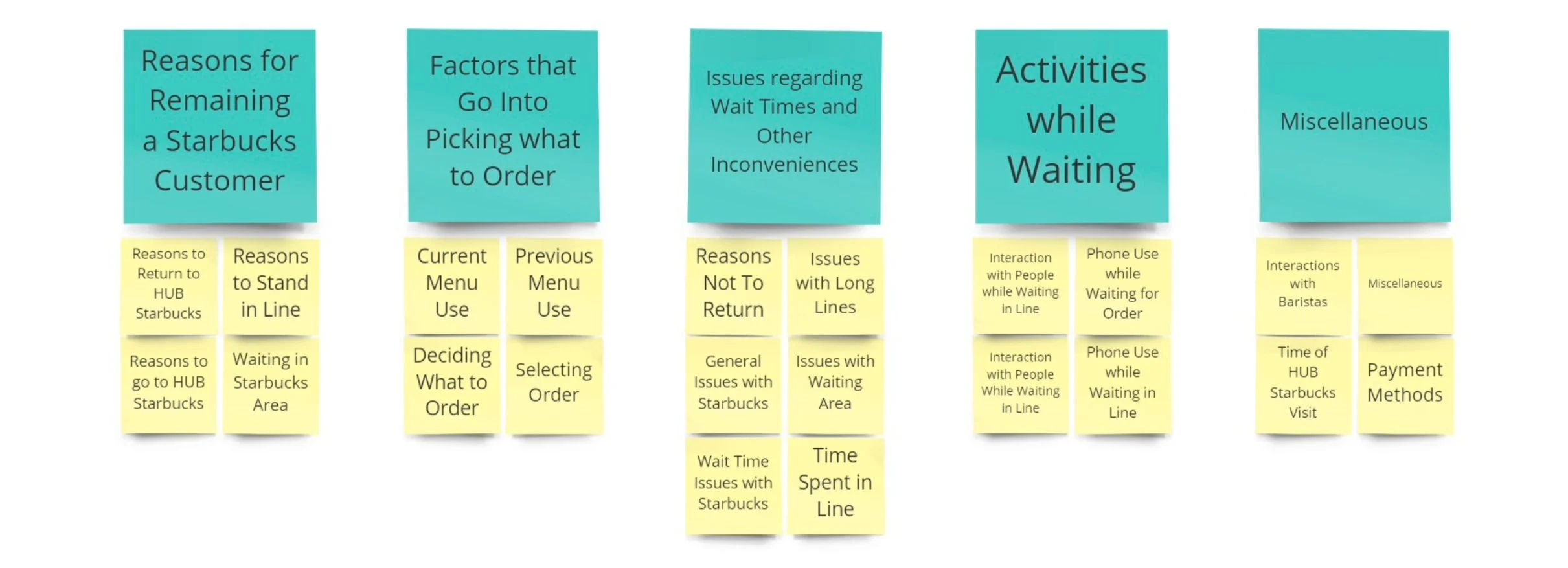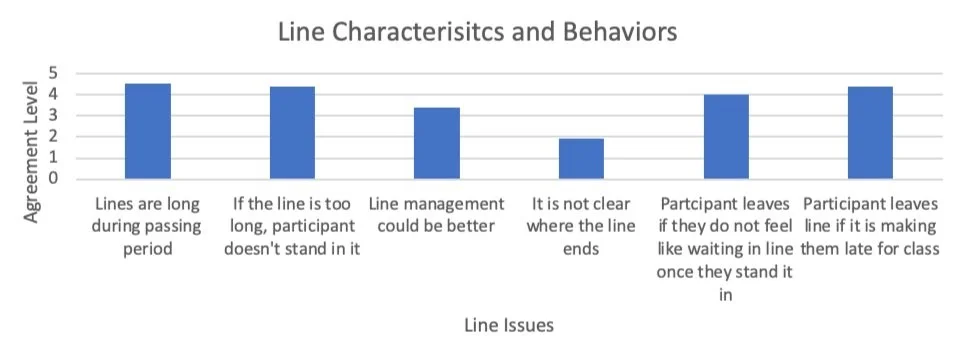Productivity in Starbucks Lines at University of Washington

OVERVIEW
Design Question
How do you reduce the waiting time for undergraduate University of Washington (UW) students getting an order from the UW Husky Union Building (HUB) Starbucks?
Solution
Increasing the waiting area space, including checkpoint timers, and linking the UW Husky Card (the dining plan card) to the Starbucks App would reduce the waiting time at the HUB.
Project Details
Duration: 10 weeks in Spring 2019
My Role: User Researcher
Tools: Miro and Microsoft Excel
RESEARCH RATIONALE
The HUB is centrally located, containing many student services and food options, which makes it a popular place for students. Many students study and meet friends at the HUB, including in the seating area next to Starbucks. Lines get very long at the HUB Starbucks, which may cause the establishment to lose customers. I decided to research how to reduce wait times at the HUB Starbucks since the findings can positively impact both customers and the establishment.
FIELD OBSERVATIONS
I started my research with field observations to gain an idea of what the environment of the HUB Starbucks is like and notice factors that affect lines. I did three 30-minute observations on three different days from 11:55 AM - 12:25 PM. I picked this time because many students have lunch around this time, which results in long lines at Starbucks to observe. I sat in different spots in a seating area next to the Starbucks, which I picked based on availability and view of the Starbucks line.
Picture I took from one of the observations that shows long line and crowded waiting area.
After observations, I used thematic analysis and color-coding to analyze the data by finding commonalities between what I observed.
Key Finding 1
The majority of people in line use their phones while waiting to order
Key Finding 2
People wait around the counter to pick up their order after ordering
Key Finding 3
The baristas do multiple tasks throughout their shifts, such as taking orders, making orders, and stocking supplies
The field observations helped me notice behaviors that I had not noticed before despite having been a customer at the HUB Starbucks. One limitation is that through observations, researchers cannot understand the thought processes of people. User interviews, the next step, address this issue.
USER INTERVIEWS
The purpose of the user interviews was to gain an understanding of the participants’ thought process behind ordering and waiting for their Starbucks order. I conducted 3 semi-structured user interviews with people who went to the HUB Starbucks at least once a quarter in the past year. All participants were undergraduate students. I analyzed the interviews using thematic analysis and affinity diagrams to find commonalities between the interviews.
I grouped findings from what participants said in interviews into themes. The green, blue, and pink sticky notes each represent a different interview, and the yellow sticky notes represent the themes. This is one out of the four pages of groupings I did:
Interview Results Affinity Diagram
I grouped the initial themes (yellow sticky notes) into larger themes (turquoise sticky notes in the image below) to come up with key findings.
Key Results Affinity Diagram
The key findings were:
Key Finding 1
All participants made changes to their order once they got into line, and the weather influenced their order
Key Finding 2
All participants used their phones while waiting to place their order and while waiting to pick up their order
Key Finding 1
Participants noted that the wait time to pick up their order was sometimes long, and the waiting area was very crowded, overwhelming, and dirty
The benefit of the user interviews was learning about the user’s motivations. One limitation is that three interviews are not representative of everyone who uses the HUB Starbucks. This limitation is addressed by surveys, the next step in this research project.
SURVEY
The purpose of the survey was to validate the findings from the field observations and user interviews. I created a survey with multiple-choice, ranking, rating, and short answer questions to verify earlier research findings and gain more insight into the HUB Starbucks waiting times. 17 responses out of 20 met the inclusion criteria (UW undergraduates familiar with the HUB Starbucks) and were included in the analysis. I analyzed the short answer questions using thematic analysis and the multiple-choice, ranking, and rating by creating graphs.
This is one of the visualizations I made when analyzing the survey data:
This bar graph analyzes a rating question asking participants to rate how much they agree with statements about the HUB Starbucks lines. These statements were taken from the interview responses.
The key findings were:
Key Finding 1
Long lines at the HUB Starbucks deter people from standing in it or cause people to want to leave the line
Key Finding 2
The waiting area is perceived as overwhelming by many since it is very crowded
Key Finding 3
Many are aware of the Starbucks app, but have various issues with using it
One of the limitations of this survey is the small sample size due to this being a class project with limited time. Another limitation is that there may also be some bias in the answers that people give.
RECOMMENDATIONS
Upon completing the research, I came up with recommendations to resolve the long lines issue at the HUB Starbucks. I also prioritized the recommendations based on their feasibility to implement and practicality for customers.
Recommendation 1
Increase waiting area space
This is the easiest to implement as it involves buying more stools and/or moving a few of the existing tables next to the Starbucks closer to the waiting area so that it is perceived as a part of the waiting area. It is practical for customers because they can complete other tasks while waiting for their order and will make the waiting area seem less overwhelming. The limitation is that it does not actually reduce the waiting time, it only reduces the perception of it.
Recommendation 1
Display wait times at certain points in the line
This takes more effort to implement since additional research needs to be done to accurately determine estimated times. If customers see that the line will take too long for them, they can choose not to stand in it, thus reducing the wait time for others. The limitation is that the estimated times may not always be accurate.
Recommendation 1
Link Husky Cards (the dining plan cards) to the Starbucks App
If students place their orders and pay through the app, they will not need to stand in line to order. They can also make the order in advance so that they can reduce their waiting time to get the order. Allowing Husky Cards to be linked to the app involves work from Starbucks and UW, which makes this solution the hardest to implement. The limitation is that if there are issues with the app, this solution will be temporarily unavailable.
I made a video summarizing the research process and detailing the survey results and recommendations:
REFLECTION
Although I had done user research before, this was my first project that focused mainly on user research.
Next Steps
I would like to get feedback on the recommendations. Additionally, I would like to implement and do usability testing on the recommendations to find out how effective they are. Based on the usability testing and perhaps additional user research, I could come up with stronger recommendations to reduce wait times at the HUB Starbucks. I would also like to conduct user research on the other on-campus Starbucks location as well as off-campus locations to see how the results compare.
Key Takeaways
Here are the main things that I learned from doing this project:
Do not make assumptions: Since I was familiar with the HUB Starbucks, it was easy for me to make assumptions about what I was observing. However, when I put my assumptions aside, I observed a lot more details that became important for my research.
Be an active listener during interviews: A lot of useful details came from the follow-up questions I asked in response to what participants had said to some of the planned questions. Formulating follow-up questions involved actively listening and processing what the participant was saying as they were talking.
I will implement these takeaways in future projects!

